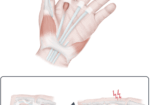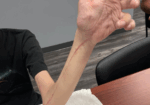Cyclist Injuries: Avoiding Hand Injuries and Treatment Strategies
Filed under Treatments
RAPID REVIEW
Chiaramonte, R., Pavone, P., Musumeci, G., Di Rosa, M., & Vecchio, M. (2022). Preventive strategies, exercises, and rehabilitation of hand neuropathy in cyclists: A systematic review. Journal of Hand Therapy, 35, 164-173.

The Skinny:
The study was a systematic review done to get clarification on the diagnostic process for cyclist injury specifically for hand neuropathies and strategies for prevention and treatment.
In the Weeds: Literature was searched in the following databases PubMed, EMBASE, the Cochran Library, and Web of Science.
Exclusion criteria excluded duplicate studies, injuries that were related to sports not specific to cycling, and articles that were not related to peripheral nerve injuries.
Inclusion criteria: Articles met the inclusion criteria if they included hand palsy due to peripheral nerve compressions of the ulnar and or median nerve specific to the cyclist injury.
Initially, the search yielded 15,371 articles, after screening for inclusion-exclusion a total of 48 full-text articles were read, and finally 20 publications that met the full criteria. Two separate reviewers independently reviewed identified articles.
Bringing it Home:

From the literature review, they concluded the following prevention and therapeutic strategies for treating common cyclist injuries.
1.) Educate cyclists on frequent changes in the position of the upper limb, neck, and shoulder
girdle (Anderson and Bovim, 1997)
2.) Adapt the handlebars or change position and change riding position (Haloua, et al,
1987)
3.) Minimize nerve compressions by avoiding prolonged elbow extension and
flexion, and wear neutral wrist orthosis and elbow orthosis at night. Use padded gloves (Dy
and Mackinnon, 2016)
4.) No treatment (Haloua et al, 1987, North et al, 1980 and Selcuk et al, 2015)
5.) Rest from the activity causing the compression (Malmaris and Zadeh, 1990)
6.) Cryotherapy, exercise, and electrical stimulation (Bransdma, 1995)
7.) Anti-inflammatory drugs and steroid injections (Ummer and Albohm, 1990).
There are a few treatments available for peripheral nerve injuries caused by cycling, however, there is no specific protocol for these injuries according to this systematic review.
Rating:
3/5
There is very limited evidence on treatment options for compression neuropathies caused by cycling. However, there have been a large number of studies looking at conservative treatment for peripheral neuropathies they are just not specific to one sport. The best course of treatment for cyclists is not clearly defined and this may require therapists to rely on their current clinical skills and other research.
References
Andersen, K. V., & Bovim, G. (1997). Impotence and nerve entrapment in long-distance amateur cyclists. Acta neurologica Scandinavica, 95(4), 233–240. https://doi.org/10.1111/j.1600-0404.1997.tb00104.x
Brandsma, J. W. (1995). Manual muscle strength testing and dynamometry for bilateral ulnar neuropraxia in a surgeon. Journal of Hand Therapy, 8(3), 191-194.
Dy, C. J., & Mackinnon, S. E. (2016). Ulnar neuropathy: evaluation and management. Current rev musculoskeletal med, 9, 178-184.
Haloua, J. P., Collin, J. P., & Coudeyre, L. (1987). Paralysis of the ulnar nerve in cyclists. Annales de Chirurgie de la Main: Organe Officiel des Societes de Chirurgie de la Main, 6(4), 282-287.
Kalainov, David & Hartigan, Brian. (2003). Bicycling-induced ulnar tunnel syndrome. American journal of orthopedics (Belle Mead, N.J.). 32. 210-1.
Maimaris, C., & Zadeh, H. G. (1990). Ulnar nerve compression in the cyclist’s hand: two case reports and review of the literature. British journal of sports medicine, 24(4), 245.
Noth, J., Dietz, V., & Mauritz, K. H. (1980). Cyclist’s palsy: Neurological and EMG study in 4 cases with distal ulnar lesions. Journal of the neurological sciences, 47(1), 111-116.
Ummer, C., & Albohm, M. (1997). Cyclist palsy in the 90s. Human kinetics. 20-21.
Selçuk, B., Kurtaran, A., Yildirim, Ö., Değirmenci, İ., & Akyüz, M. (2015). Cyclist’s Neuropathy: A Compression Syndrome of the Deep Motor Branch of the Ulnar Nerve: A Case Report. Neurosurgery Quarterly, 25(3), 337-340.
1 Comment
Leave a Comment
More To Read
Simple but Effective Ways Hand Therapists Address Psychosocial Impacts of Upper Extremity Injuries
Although psychosocial factors are often not formally assessed during an evaluation in those with upper extremity injuries, the therapist often informally assesses these during and after treatment sessions. Sustaining an upper extremity injury can be a physically and emotionally challenging experience. Beyond the physical pain and limitations, these injuries can profoundly impact an individual’s psychosocial…
Read MoreVagus Nerve Stimulation (VNS) for Various Etiologies
What is it: Vagus nerve stimulation (VNS) is a medical treatment that uses a device to deliver electrical impulses to the vagus nerve, which runs on both sides of the body from the lower brain through the neck to the chest and stomach. The left vagus nerve is typically used for this procedure, as simulating…
Read MoreWound Healing Complications in Diabetic Patients who have undergone a Carpal Tunnel or Trigger Finger Release
By: Amalia Garcia Gundlach, B. K., Robbins, C. B., Lawton, J. N., & Lien, J. R. (2021). Wound Healing Complications in Diabetic Patients Undergoing Carpal Tunnel and Trigger Finger Releases: A Retrospective Cohort Study. The Journal of Hand Surgery, S0363502321003014. https://doi.org/10.1016/j.jhsa.2021.05.009 The Skinny – carpal tunnel and diabetes In general, individuals with diabetes are more…
Read MoreArteriovenous Malformation (AVM hand)
By: Amalia Garcia Introduction After completing three weeks of my Level II hand therapy rotation, I have seen a wide variety of common upper extremity injuries such as carpal tunnel syndrome, distal radius fractures, mallet finger, flexor tendon lacerations, arthritis, and more. One condition that stood out to me was one that I hadn’t heard…
Read MoreSign-up to Get Updates Straight to Your Inbox!
Sign up with us and we will send you regular blog posts on everything hand therapy, notices every time we upload new videos and tutorials, along with handout, protocols, and other useful information.







As a triathlete and a CHT this has burdened me for quite some time.
I struggle to find a balance between a comfortable grip on my handlebars and preventing hand numbness.